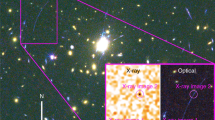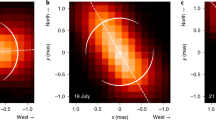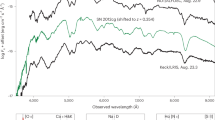Abstract
The nature of dark matter remains mysterious, with luminous material accounting for at most ∼25 per cent of the baryons in the Universe1,2. We accordingly undertook a survey looking for the microlensing of stars in the Large Magellanic Cloud (LMC) to determine the fraction of Galactic dark matter contained in massive compact halo objects (MACHOs). The presence of the dark matter would be revealed by gravitational lensing of the light from an LMC star as the foreground dark matter moves across the line of sight. The duration of the lensing event is the key observable parameter, but gives non-unique solutions when attempting to estimate the mass, distance and transverse velocity of the lens. The survey results to date indicate that between 8 and 50 per cent of the baryonic mass of the Galactic halo is in the form of MACHOs (ref. 3), but removing the degeneracy by identifying a lensing object would tighten the constraints on the mass in MACHOs. Here we report a direct image of a microlens, revealing it to be a nearby low-mass star in the disk of the Milky Way. This is consistent with the expected frequency of nearby stars acting as lenses, and demonstrates a direct determination of a lens mass from a microlensing event. Complete solutions such as this for halo microlensing events will probe directly the nature of the MACHOs.
This is a preview of subscription content, access via your institution
Access options
Subscribe to this journal
Receive 51 print issues and online access
$199.00 per year
only $3.90 per issue
Buy this article
- Purchase on Springer Link
- Instant access to full article PDF
Prices may be subject to local taxes which are calculated during checkout


Similar content being viewed by others
References
Hogan, C. J. Gravitational lensing by cold dark matter catastrophes. Astrophys. J. 527, 42–45 (1999).
Tytler, D., O'Meara, J. M., Suzuki, N. & Lubin, D. Deuterium and the baryonic density of the universe. Phys. Rev. 333, 409–432 (2000).
Alcock, C. et al. The MACHO Project: Microlensing results from 5.7 years of Large Magellanic Cloud observations. Astrophys. J. 542, 281–307 (2000).
Alcock, C. et al. The MACHO Project Hubble Space Telescope follow-up: Preliminary results on the location of the Large Magellanic Cloud microlensing source stars. Astrophys. J. 552, 582–590 (2000).
Alcock, C. et al. The MACHO Project Large Magellanic Cloud microlensing results from the first two years and the nature of the Galactic dark halo. Astrophys. J. 486, 697–726 (1997).
Gould, A., Bahcall, J. N. & Flynn, C. M dwarfs from Hubble Space Telescope star counts. III. The Groth Strip. Astrophys. J. 482, 913–918 (1997).
Holtzman, J. A. et al. The photometric performance and calibration of WFPC2. Proc. Astron. Soc. Pacif. 107, 1065–1093 (1995).
Alcock, C. et al. First observation of parallax in a gravitational microlensing event. Astrophys. J. 454, L125–L128 (1995).
Gould, A. Extending the MACHO search to ∼106 M⊙. Astrophys. J. 392, 422–451 (1992).
Bessell, M. S. The late M dwarfs. Astrophys. J. 101, 662–676 (1991).
Cassisi, S., Castellani, V., Ciarcelluti, P., Piotto, G. & Zoccali, M. Galactic globular clusters as a test for very-low-mass stellar models. Mon. Not. R. Astron. Sco. 315, 679–688 (2000).
Reid, N. Unresolved binaries and the stellar luminosity function. Astron. J. 102, 1428–1438 (1991).
Zheng, Z., Flynn, C., Gould, A., Bahcall, J. N. & Salim, S. M dwarfs from Hubble Space Telescope star counts. IV. Astrophys. J. 555, 393–404 (2001).
Acknowledgements
We thank the ESO director for discretionary time on the VLT. This work was supported by NASA and the Space Telescope Science Institute, which is operated by the Association of Universities for Research in Astronomy. This work was performed under the auspices of the US Department of Energy by the University of California, Lawrence Livermore National Laboratory. Work performed by the Center for Particle Astrophysics personnel is supported in part by the Office of Science and Technology Centers of the NSF. C.W.S. thanks the Packard foundation for support. W.J.S. is supported by a PPARC advanced fellowship. C.A.N. is supported in part by an NPSC Graduate Fellowship. T.V. and K.G. were supported in part by the US DOE. D.M. is supported by Fondecyt.
Author information
Authors and Affiliations
Corresponding author
Ethics declarations
Competing interests
The authors declare no competing financial interests.
Rights and permissions
About this article
Cite this article
Alcock, C., Allsman, R., Alves, D. et al. Direct detection of a microlens in the Milky Way. Nature 414, 617–619 (2001). https://doi.org/10.1038/414617a
Received:
Accepted:
Issue Date:
DOI: https://doi.org/10.1038/414617a
This article is cited by
-
Search for exotic matter from gravitational microlensing observations of stars
Astrophysics and Space Science (2008)
-
Extrasolar planets
Nature (2002)
-
Gravitational microlens in motion
Nature (2001)
Comments
By submitting a comment you agree to abide by our Terms and Community Guidelines. If you find something abusive or that does not comply with our terms or guidelines please flag it as inappropriate.



